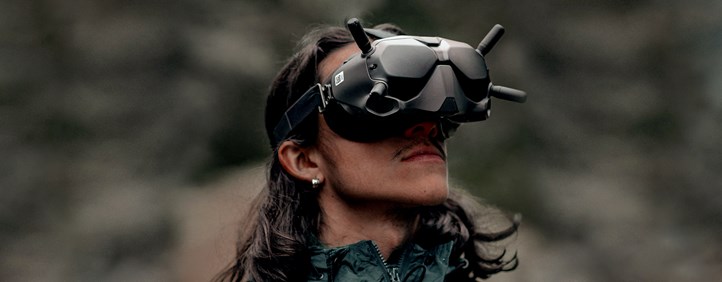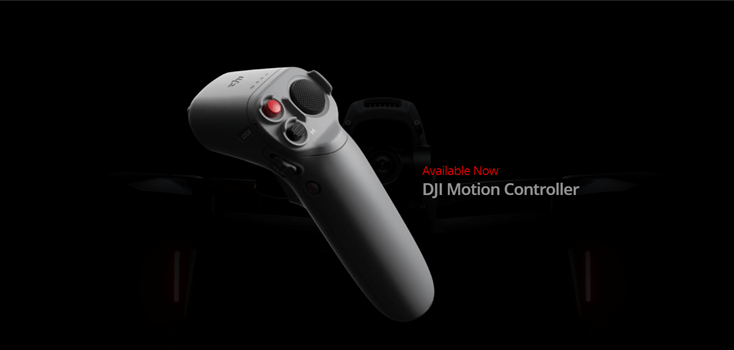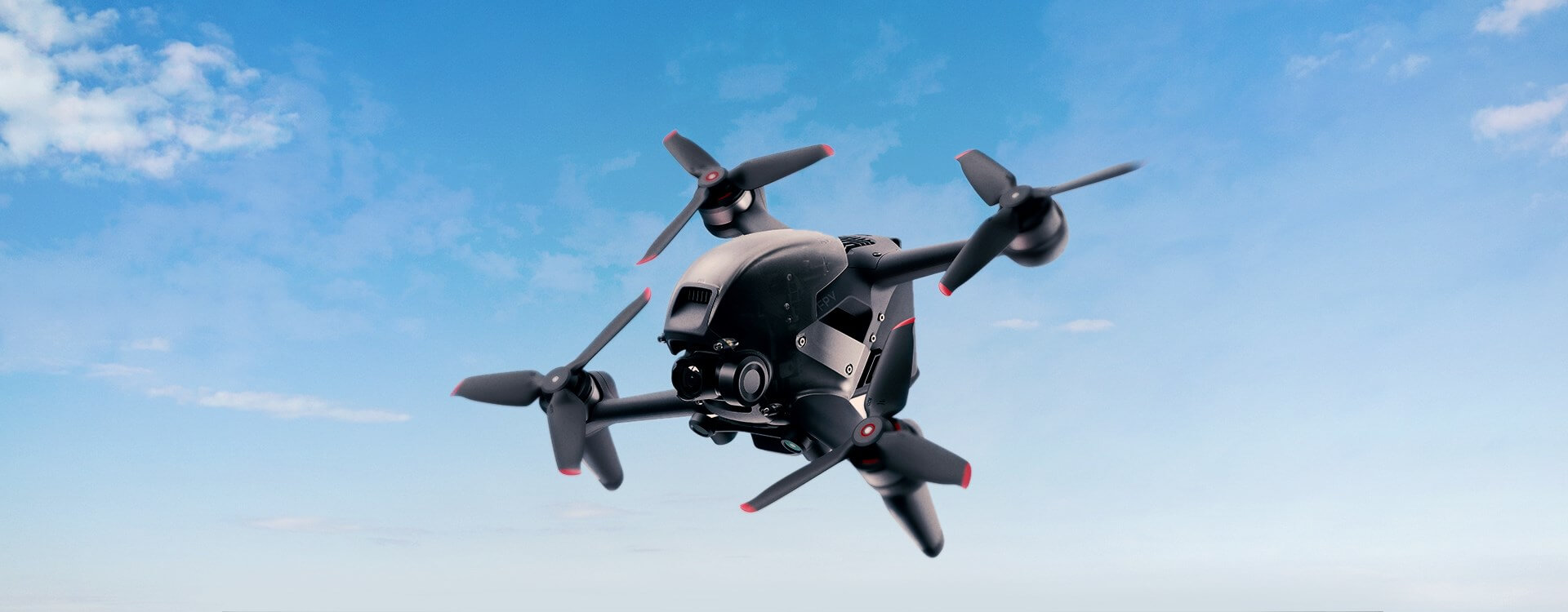Highlights
Table of Contents
Explore article topics
In case you didn’t know already, FPV (first-person view) drones are all the rage right now. Perhaps you’ve already read our introduction to the world of FPV drones. Unsurprisingly, with the rise in popularity of this new drone technology, DJI has now finally jumped on board, releasing their very own DJI FPV drone. This new DJI drone is unlike anything else the company has produced before, yet at the same time, it retains the essential qualities and assurances that have made DJI the force it is today.
Below, we’re taking a closer look at the new DJI FPV drone.
Before that, check out our FPV drone music collection, full of high-energy songs that will add excitement to your FPV videos.
Specs breakdown
Before anything else, let’s have a look at the specs for this new DJI drone. We’ve highlighted some of the key aspects, but for a deeper analysis, you can find the full details on their website, including info about the DJI FPV Goggles and more.
| Weight | 795g |
| Dimensions | 255×312×127 mm (with propellers)
178×232×127 mm (without propellers) |
| Max speed | 140kph |
| Max flight distance | 16.8 km |
| Video resolution | 4K: 3840×2160 at 50/60fps
FHD: 1920×1080 at 50/60/100/120fps |
| Battery life | Approximately 20 minutes (it depends how hard you fly, but this is brilliant) |
Everything is streamlined
First impressions out of the box: The DJI FPV drone is clearly made with beginners in mind, offering a very smooth way to get into FPV drone flying. DJI has taken complicated technology and made it simple to use.
If there’s one thing you may have noticed when getting into FPV drone flying, it’s how complicated and unapproachable the niche can be. It’s never been like normal consumer drones where you could just take the drone straight out of the box and go. The DJI FPV drone—which DJI touts as ‘Ready-to-Fly’—changes all of that. Suddenly, everything has been streamlined. You no longer need to understand complicated electronics, soldering, motor mechanics, or which transmitter does what. It’s a game-changer.
Design and hardware
Taking a look at design and hardware, the new FPV is exactly what we’ve come to expect from DJI. The build quality is incredibly strong and sturdy, which, for an FPV drone, is paramount. It feels like it can take a hit.
Propellers
Just like any other new DJI drone, you’ll find that the propellers easily clip and lock on. You can also purchase propeller props which we would highly recommend. They’re a nice safety cushion to protect from the worst damage on impact, and we’ve found that they don’t impact flight capability at all.
Batteries
Next, the 2000mAh battery. For FPV drone batteries, it’s big. However, with a larger size comes a longer flight time. You’ll be able to fly this new DJI drone for up to 20 minutes, which is an incredible jump from other FPV models on the market, most of which offer only around 5 minutes per battery). The battery itself pops in and out of the back of the craft with ease, and it’s a friendly, simple plug-in-and-charge system. Unlike other, more complicated FPV models, the DJI FPV drone batteries don’t require you to worry about voltages and storage. If you don’t use them for a while, they will automatically enter a storage state where they safely discharge and preserve energy.
Goggles

A look that can not be ignored
How about the new DJI FPV goggles? Depending on your taste, you’ll either think they look ridiculous or insanely cool. We can’t help thinking of the Dark Knight trilogy whenever we see them. FPV goggles are notoriously hard to pull off wearing without looking a little strange, but we think DJI did a great job here. They’re very comfortable to wear, and the preview image inside is really crisp—perfect for avoiding all of those oncoming obstacles.
Camera
As for the camera itself, the DJI FPV drone shares the same 1/2.3″ CMOS sensor as the DJI Mavic Mini 2. So yes, the quality isn’t amazing compared with some of the flagship pro-grade models, but it’s really all you need for the FPV experience.
We’ve found that the camera performs very well during daylight, though starts to struggle with noise and loss of detail in darker situations. You’ll find that it’s capable of filming 4K at 60fps and up to 120fps at 1080p—perfect for slowing down those epic toe-curling shots or near misses.
The DJI FPV camera is mounted on a one-axis gimbal (a simple up/down). One thing that’s noticeable here is that you’re getting a super-wide view of 150 degrees, which means you can see the ends of your propellers in your footage (kind of like the old DJI Phantom drones). This is for gauging how close things are to your craft but not so good for the final footage. You’ll need to apply lens correction in post.
Flying the drone
So, what’s this DJI FPV like to fly? We’ve already mentioned how brilliant the DJI FPV goggles are, and it doesn’t stop there. The theme of taking a simple, streamlined approach to FPV drone flying runs throughout the design and software of this drone.
The simulator
When you turn on the DJI FPV for the first time, you’ll find that you can enter into a training mode for beginners. Using your phone to connect to the DJI FPV goggles, you can use your controller to fly around in a simulator and get used to how the drone will handle in real life. It’s a very clever and important feature that should help you avoid a few early crashes.
Flight modes
Next, when it comes to the actual flight, there are three modes to choose from:
- Normal. This is the easy mode and where you should start. It flies very similarly to any of the Mavic models, using its sensors for obstacle avoidance and providing auto-leveling that maintains altitude and a speed cap of 31mph.
- Sport. In sport mode, you’ll find that it’s still similar to the Mavic series in terms of how it flies, but there’s a lot more speed involved. It’s kind of like the halfway point between Normal and Full manual, offering max speeds of up to 60mph but still offering things like auto-leveling.
- Full manual. Be careful! This is where all brakes are off. In manual mode, you’re in total control and can do all of the things this new DJI drone was meant to do. Flips, rolls, speeds of 97mph…it’s all here. We recommend going into this mode only when you’re comfortable with the previous 2 and have a vast open space with no people around where you can practice safely.
Flying with motion control

Source: dji.com
Interestingly, DJI gives you the option to purchase a special motion-control pad which is a whole new, different way to fly this DJI FPV drone. We love it! It’s really intuitive and sharp, reacting to any movement you make with your hands. After a few hours, it feels like second nature. We’re very intrigued to see where this technology goes and whether this may well end up being the future of FPV drone controllers.
You won’t get lost
Another little feature we highly appreciate while flying is the ‘H’ icon that marks where you (the drone pilot) are standing in relation to what the drone is seeing. This can really help you get out of a sticky situation where you end up lost because you got disorientated or flew too far away. When you see the ‘H’ on screen, flying toward it will bring the drone back to you. It’s genius!
Get unlimited royalty-free 4K footage
Abort abort abort
It’s inevitable that at some point, you might land yourself in hot water (hopefully not literally). Sometimes, when performing crazy moves with your FPV drone, you’ll make a mistake or feel like you need to bail out. It’s like a jet pilot when they realize they need to eject.
DJI has literally given us a bail-out option in the shape of the Pause button. Hitting this at any moment will bring the DJI FPV drone to an immediate halt, and it will hover in place while you collect yourself. Once you know it’s there, you’ll be using it a lot.
The RTH feature
Just like any other DJI drone, the FPV offers you a fail-safe in the form of the ‘Return to Home’ feature. If you ever get a weak video signal or lose connection altogether, the drone will automatically stop and hover before using its sensors to fly back home (where you’re standing). It’s hard to underestimate just how important this is.
This feature gives you peace of mind, allowing you to fly with more confidence and attempt more daring maneuvers. No other FPV drone on the market is offering this.
Final thoughts
So, that’s the new DJI FPV Drone. DJI’s first foray into the FPV world is a brilliant one. Yes, the camera is a little average; yes, it’s bigger and bulkier than other FPV drones on the market; and yes, at an MSRP of $1,299 US, it’s really expensive.
However, in terms of opening up the world of FPV drones to the average consumer, it’s hard to find anything else nearly as good as this. DJI has streamlined everything and made what was once a very unapproachable, daring niche something that anyone can now engage with.
Considering this is their first attempt, it’s nothing short of remarkable. We cannot wait to see how DJI’s FPV line evolves over the next decade.
If you enjoyed this article and are looking at getting into drones, be sure to check out our articles covering aerial footage and the establishing shot.
We’ve also got a great collection of music that’s perfect for your FPV drone footage!
Josh Edwards is an accomplished filmmaker, industry writing veteran, storyteller based in Indonesia (by way of the UK), and industry writer in the Blade Ronner Media Writing Collective. He's passionate about travel and documents adventures and stories through his films.
Share this article
Did you find this article useful?
Related Posts
- By Daniela Bowker
- 9 MIN READ
- By Robert Hardy
- 1 MIN READ
Latest Posts
- 17 Apr
- By Daniela Bowker
- 7 MIN READ


